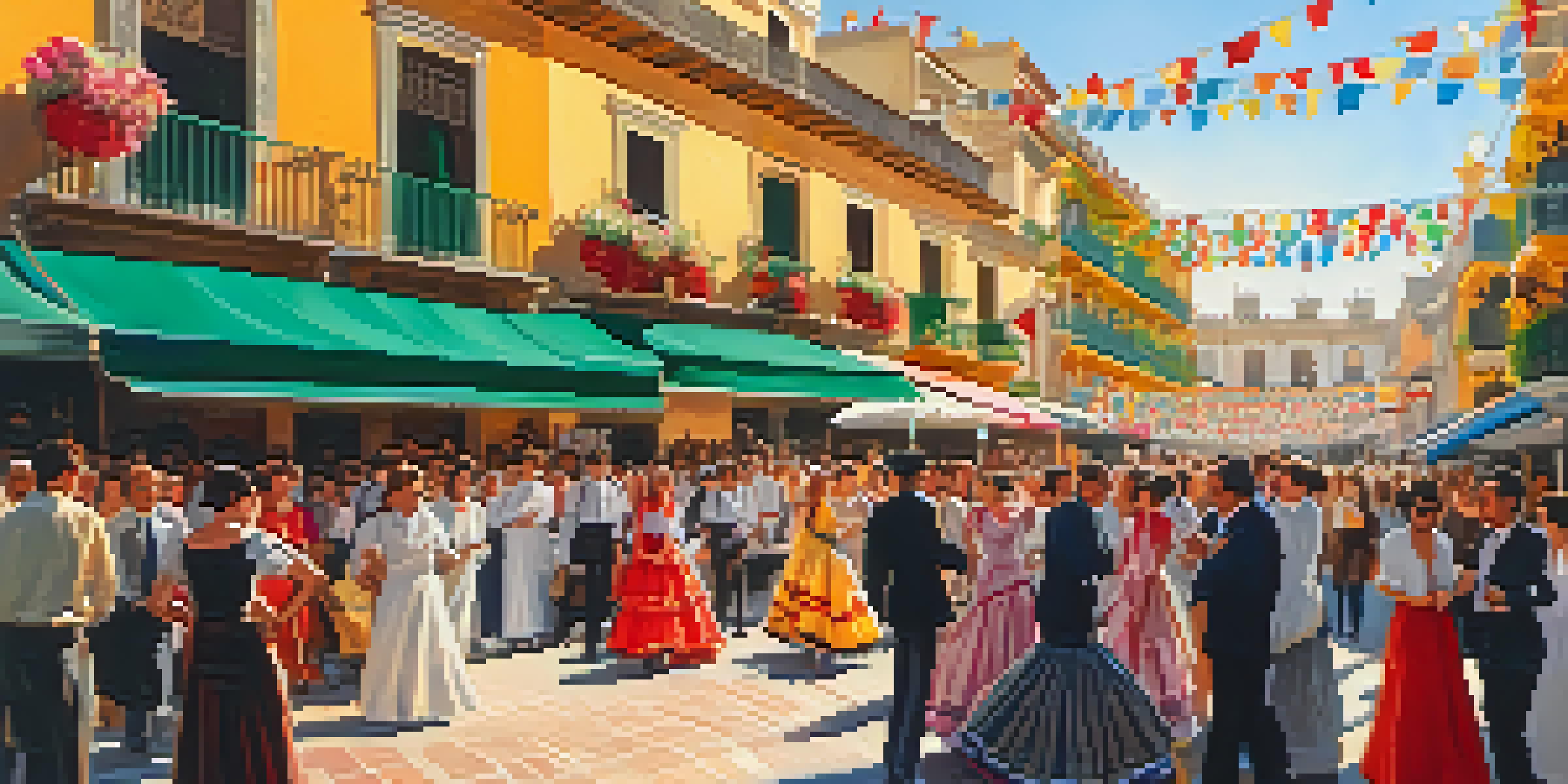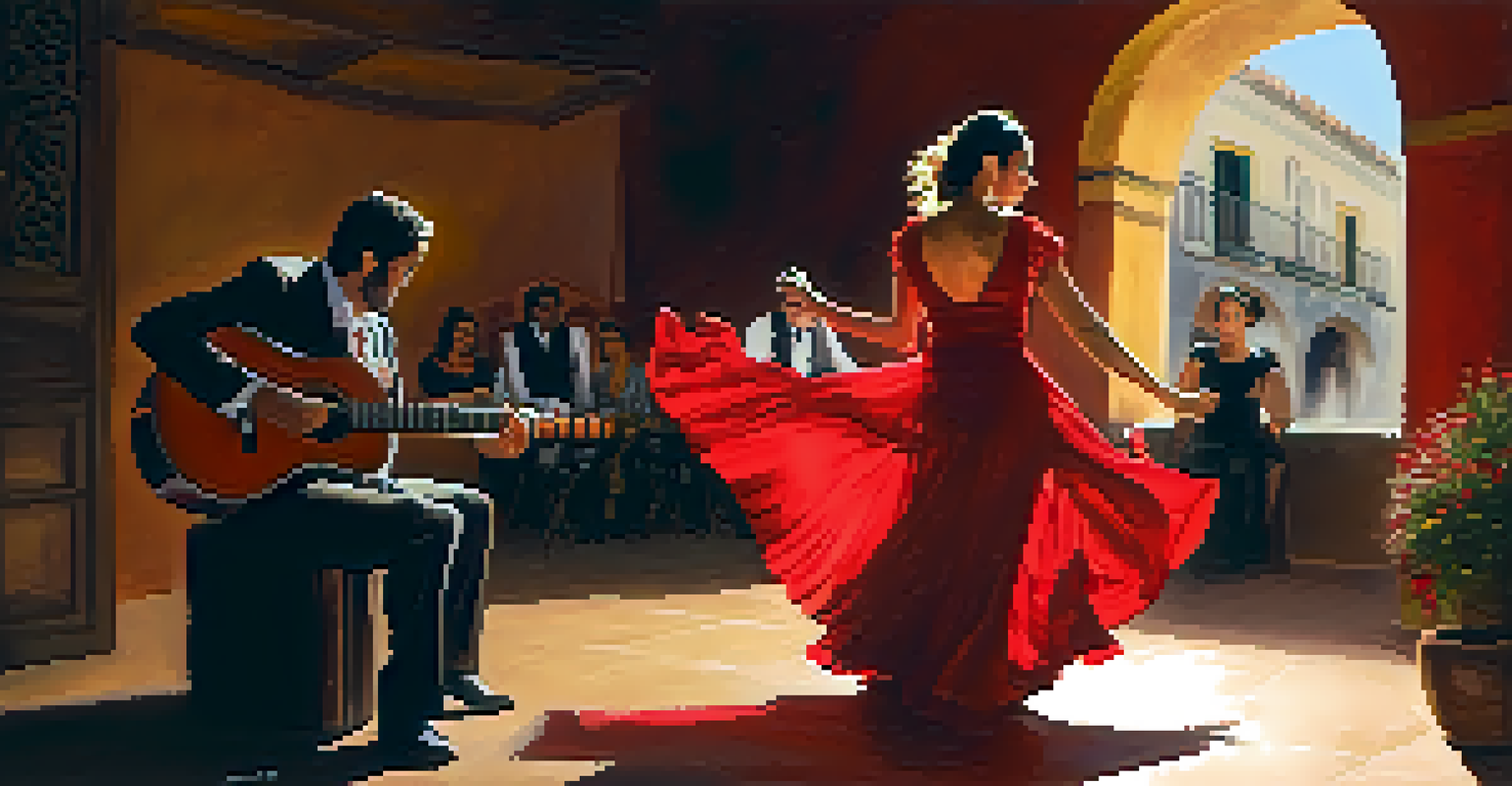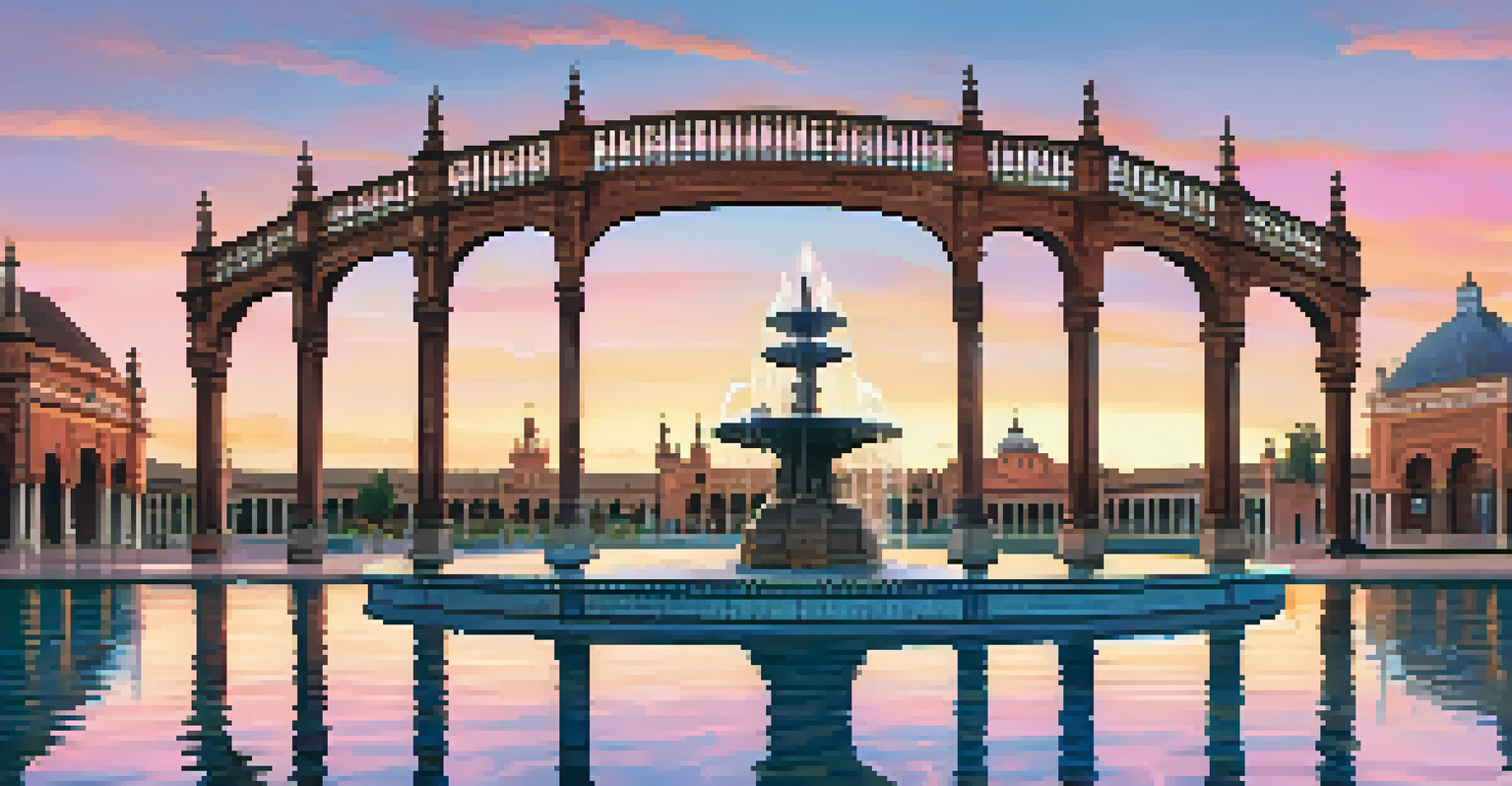Art and Culture: Catalysts for Urban Tourism in Seville

Seville's Rich Artistic Heritage: A Gateway for Tourists
Seville is a city steeped in rich artistic heritage, making it a magnet for tourists. From the stunning architecture of the Alcázar to the intricate details of its Gothic cathedral, every corner tells a story. This historic backdrop not only draws visitors but also provides a canvas for local artists to showcase their talents. Consequently, the city's artistic allure becomes a catalyst for urban tourism, inviting exploration and discovery.
Seville is a city that inspires imagination and creativity, where every street and plaza tells a story of art and culture.
The city's annual festivals, like the Feria de Abril and Semana Santa, further enrich its cultural tapestry. These events transform the city into a vibrant stage, where traditional music, dance, and art come to life. Tourists flock to witness these colorful celebrations, creating an immersive experience that goes beyond mere sightseeing. In essence, these festivities serve as a bridge connecting visitors to Seville's deep-rooted traditions.
Moreover, art galleries and museums throughout Seville provide a glimpse into the city's contemporary artistic scene. With local artists gaining recognition and international acclaim, tourists are not only spectators but also participants in an evolving cultural narrative. This dynamic interplay between history and modernity enhances Seville's appeal, making it a must-visit destination for those seeking both art and culture.
Flamenco: The Heartbeat of Seville's Cultural Scene
Flamenco is more than just a dance; it's the very heartbeat of Seville's cultural identity. Originating from Andalusian folklore, this passionate art form captivates both locals and tourists alike. Visitors often find themselves enchanted by the rhythm of the guitar, the soulful singing, and the expressive movements of the dancers. This powerful connection to flamenco acts as a significant draw for urban tourism in Seville.

The city is home to numerous tablaos, or flamenco venues, where tourists can experience live performances in an intimate setting. These venues immerse visitors in the spirit of flamenco, creating lasting memories and a deeper appreciation for the art form. Each performance is a celebration of emotion, history, and community, inviting spectators to feel the essence of Seville.
Seville's Artistic Heritage Shines
Seville's rich artistic heritage, from its stunning architecture to vibrant festivals, creates a compelling draw for tourists.
Furthermore, flamenco workshops offer tourists the chance to learn the dance, fostering a hands-on connection to the culture. When tourists engage with flamenco beyond observation, they become part of Seville's vibrant community. This participatory element enhances the overall tourism experience, making it not just about watching but also about understanding and embracing the local culture.
Culinary Arts: A Delicious Aspect of Urban Tourism
Seville's culinary scene is another vital component of its cultural allure, enticing food lovers from around the globe. The city’s tapas bars and restaurants showcase a fusion of flavors, highlighting traditional Andalusian dishes. From savory jamón ibérico to refreshing gazpacho, the culinary offerings tell a story of the region's history and its diverse influences. This gastronomic adventure becomes a key reason for tourists to explore Seville.
Art is the most beautiful of all lies, and in Seville, it becomes a vibrant reality.
Food markets, like Mercado de Triana, provide an authentic taste of local life, where tourists can sample fresh produce and artisanal products. These vibrant spaces not only serve delicious food but also foster a sense of community and connection. Here, visitors can interact with local vendors, gaining insights into the culinary traditions that shape Seville's identity.
Additionally, cooking classes offer tourists the opportunity to learn how to prepare traditional dishes. This hands-on experience allows visitors to take a piece of Seville home with them, creating lasting memories and a deeper appreciation for the local culture. Culinary arts thus play a pivotal role in enhancing urban tourism, making Seville a feast for the senses.
Art Festivals: Transforming Seville into a Cultural Hub
Seville is home to a variety of art festivals throughout the year, further cementing its status as a cultural hub. Events like the Seville European Film Festival and the Bienal de Flamenco attract artists and audiences from around the world. These festivals not only showcase local talent but also promote international art forms, enriching the city's cultural landscape. As a result, they play a significant role in drawing tourists eager to engage with the arts.
During these festivals, the city transforms into a vibrant canvas filled with performances, exhibitions, and workshops. Streets come alive with art installations and live performances, creating an immersive experience for visitors. This energetic atmosphere makes Seville a lively destination, encouraging tourists to explore and interact with the city's cultural offerings.
Flamenco: A Cultural Beacon
Flamenco serves as the heartbeat of Seville's culture, enticing visitors through passionate performances and interactive workshops.
Moreover, the combination of traditional and contemporary art forms during these festivals allows for a rich dialogue between different artistic expressions. This diversity attracts a wide range of tourists, from art aficionados to casual attendees looking for unique experiences. Ultimately, art festivals serve as powerful catalysts for urban tourism, enhancing Seville's appeal as a destination for cultural exploration.
Architectural Wonders: Attracting Urban Explorers
Seville's architecture is a stunning blend of historical and modern designs that captures the imagination of urban explorers. The iconic Plaza de España, with its grand semi-circular building and colorful tiles, is a must-see for any visitor. Likewise, the Giralda tower and the Metropol Parasol showcase the city's architectural diversity, drawing in tourists eager to capture the perfect photo. These landmarks not only stand as symbols of Seville but also serve as focal points for urban tourism.
Walking through the narrow streets of the Santa Cruz neighborhood, tourists can appreciate the intricate details of traditional Andalusian architecture. The charming whitewashed buildings adorned with vibrant flowers create a picturesque setting that invites exploration. This immersive experience allows visitors to connect with the history and culture of Seville on a deeper level.
Additionally, guided architectural tours provide insights into the stories behind these masterpieces. Tourists learn about the influences that shaped Seville's unique architectural style, from Moorish to Gothic and beyond. This educational aspect enriches the tourism experience, making it not just about viewing buildings but understanding their historical significance.
Museums and Galleries: Windows into Seville's Soul
Seville's museums and galleries are vital in showcasing the city's rich cultural heritage and contemporary art scene. The Museo de Bellas Artes, for instance, houses an impressive collection of Spanish paintings, providing a glimpse into the artistic evolution of the region. Visitors can immerse themselves in the works of renowned artists like Murillo and Zurbarán, fostering a connection to Seville's artistic legacy. This cultural enrichment is a compelling reason for tourists to explore the city's museums.
In addition to traditional art collections, contemporary galleries like the CAAC (Centro Andaluz de Arte Contemporáneo) highlight the works of modern artists. These spaces encourage dialogue about current social and cultural issues, making art accessible and relevant to today's audiences. Tourists are often surprised to discover the innovative and thought-provoking art being created in Seville.
Culinary Delights Enhance Tourism
Seville's culinary scene, featuring tapas and cooking classes, offers tourists a delicious way to connect with the local culture.
Furthermore, temporary exhibitions draw in visitors by showcasing diverse artistic expressions from around the world. These exhibitions keep the cultural landscape fresh and exciting, enticing repeat visitors to return. Overall, museums and galleries serve as windows into Seville's soul, making them essential stops for urban tourists seeking a deeper understanding of the city.
The Role of Local Artisans in Cultural Tourism
Local artisans play a crucial role in Seville's cultural tourism by preserving traditional crafts and creating unique souvenirs. From hand-painted ceramics to intricate lacework, these crafts embody the city's rich heritage. Tourists are often drawn to local markets and workshops, eager to take home a piece of Seville's artistic spirit. This engagement with artisans enhances the overall tourism experience, fostering a connection between visitors and the local culture.
Artisan workshops offer tourists an opportunity to learn about traditional crafts firsthand. Participating in these workshops allows visitors to appreciate the skill and dedication that goes into each piece. This hands-on experience deepens the connection to the culture and provides a memorable takeaway from their trip to Seville.

Moreover, supporting local artisans contributes to the economy and helps sustain cultural traditions. Tourists who purchase handcrafted items are not just buying souvenirs; they are investing in the stories and heritage of Seville. By valuing local craftsmanship, visitors become part of a larger narrative that celebrates the city's artistic identity.
Conclusion: Art and Culture as Urban Tourism Catalysts
In conclusion, art and culture are at the heart of Seville's urban tourism landscape. The city's rich artistic heritage, vibrant festivals, and culinary delights create a captivating experience for visitors. Each element, from flamenco to architecture, weaves together a tapestry that reflects Seville's unique identity. This cultural richness not only attracts tourists but also encourages them to engage with the city on a deeper level.
As tourists explore Seville, they become part of a living cultural narrative that continues to evolve. The interplay between tradition and modernity enriches their experience, leaving them with a lasting impression of the city's beauty and vibrancy. It’s this dynamic relationship that makes Seville a top destination for those seeking both art and culture.
Ultimately, the city's commitment to preserving its artistic heritage while embracing contemporary expressions ensures that Seville remains a vibrant hub for urban tourism. By celebrating its culture, Seville invites visitors to discover, engage, and fall in love with its artistic soul, making it a true gem in the heart of Spain.